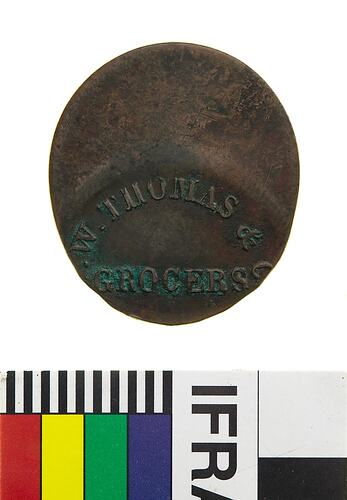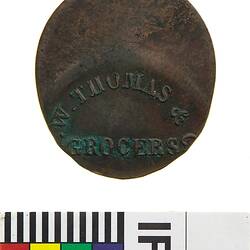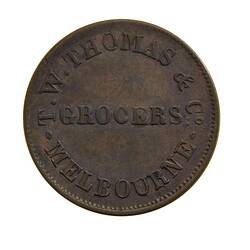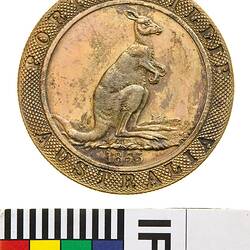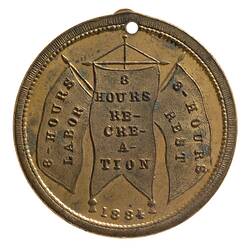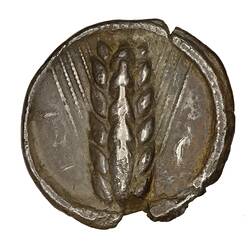Summary
Copper Halfpenny token, misstrike, minted by Kangaroo Office, Melbourne, using dies manufactured in Melbourne. Issued by T.W. Thomas & Co, Grocers, Melbourne, circa 1854. Struck to commemorate the arrival of Sir Charles Hotham on 22 June 1854. T.W. Thomas and Co. opened a grocer's business during 1854 in Melbourne. An advertisement for 'T.W. Thomas and Co., Old East India Stores, corner of Bourke and Swanston Streets' appeared in The Argus, Monday 23 April 1855, p.3 stock included: Teas, Coffees, Sugar, sauces, oils, pickles, vinegar, soaps, rice, jellies, cheese, matches, hams, spices, coconuts, starches, pasta (macaroni and vermicelli) and tinned fish. Thomas & Co is said to have become insolvent while trading in Melbourne, and during a meeting he is alleged to have threatened to drive his creditors into the street with a horse whip. Thomas is thought to have returned to Tasmania after 1859.
The lettering is badly formed due to the mis-striking of the piece and appears ornamental which led early cataloguers to describe it as a new type.
Previous Collections: George McArthur
Physical Description
A mis-strike of a copper halfpenny trade token (28 * 33 mm). It features the name and business of the issuing firm: T.W. THOMAS & Co., grocers Melbourne and commemorates on the reverse the arrival of Sir Charles Hotham on 22 June 1854. The lettering is badly formed due to the mis-striking of the piece and appears ornamental.
Obverse Description
Legend in three lines: T.W. THOMAS & Co / GROCERS [/ MELBOURNE] bottom of legend off flan
Reverse Description
At centre in five lines: SIR / CHARLES / HOTHAM / [22ND JUNE / 1854]; around, [IN COMME]MORATION OF THE LA[NDING OF] - parts in square brackets off bottom of flan.
Edge Description
Plain
Significance
This piece is the source for Andrews type 577. It is based based on Chitty who owned and published it as a seperate type with ornamental lettering, see also museum 1922 catalogue p.111 with comment in pencil by Kenyon "misstruck'. The lettering is badly formed due to the mis-striking of the piece and appears ornamental.
More Information
-
Collecting Areas
-
Acquisition Information
Transfer from National Gallery of Victoria (NGV), Mr Alfred Chitty, 15 Mar 1976
-
Date Issued
1854 AD
-
Issued By
Thomas, T.W. & Co, Melbourne, Greater Melbourne, Victoria, Australia, 1854
-
Mint
Kangaroo Office (Mint), Melbourne, Greater Melbourne, Victoria, Australia, 1854
-
Person Named
Sir Charles Hotham, Melbourne, Greater Melbourne, Victoria, Australia, 1854
-
Previous Collection
-
Inscriptions
Obverse: T.W. THOMAS & Co GROCERS MELBOURNE Reverse: IN COMMEMORATION OF THE LANDING OF SIR CHARLES HOTHAM 22ND JUNE 1854
-
Denomination
-
Series
-
Material
Copper
-
Axis
12
-
Classification
-
Category
-
Discipline
-
Type of item
-
Dimensions
33 mm (Length), 29 mm (Width), 8.174 g (Weight)
-
Shape
Oval
-
References
This piece is the source of Andrews 577 based on Chitty see museum 1922 catalogue p.111 with comment in pencil by Kenyon "misstruck'
[Book] Heyde, Gilbert C. & Skinner, Dion H. 1967. Unofficial Coins of Colonial Australia and New Zealand., No. 249/2
[Book] Andrews, Arthur. 1921. Australasian Tokens and Coins., No. 576
[Article] Sharples, John P. 1993. A Catalogue of the Trade Tokens of Victoria 1848 to 1862. Journal of the Numismatic Association of Australia. vol.7: p.1-77., V. 172
-
Keywords
